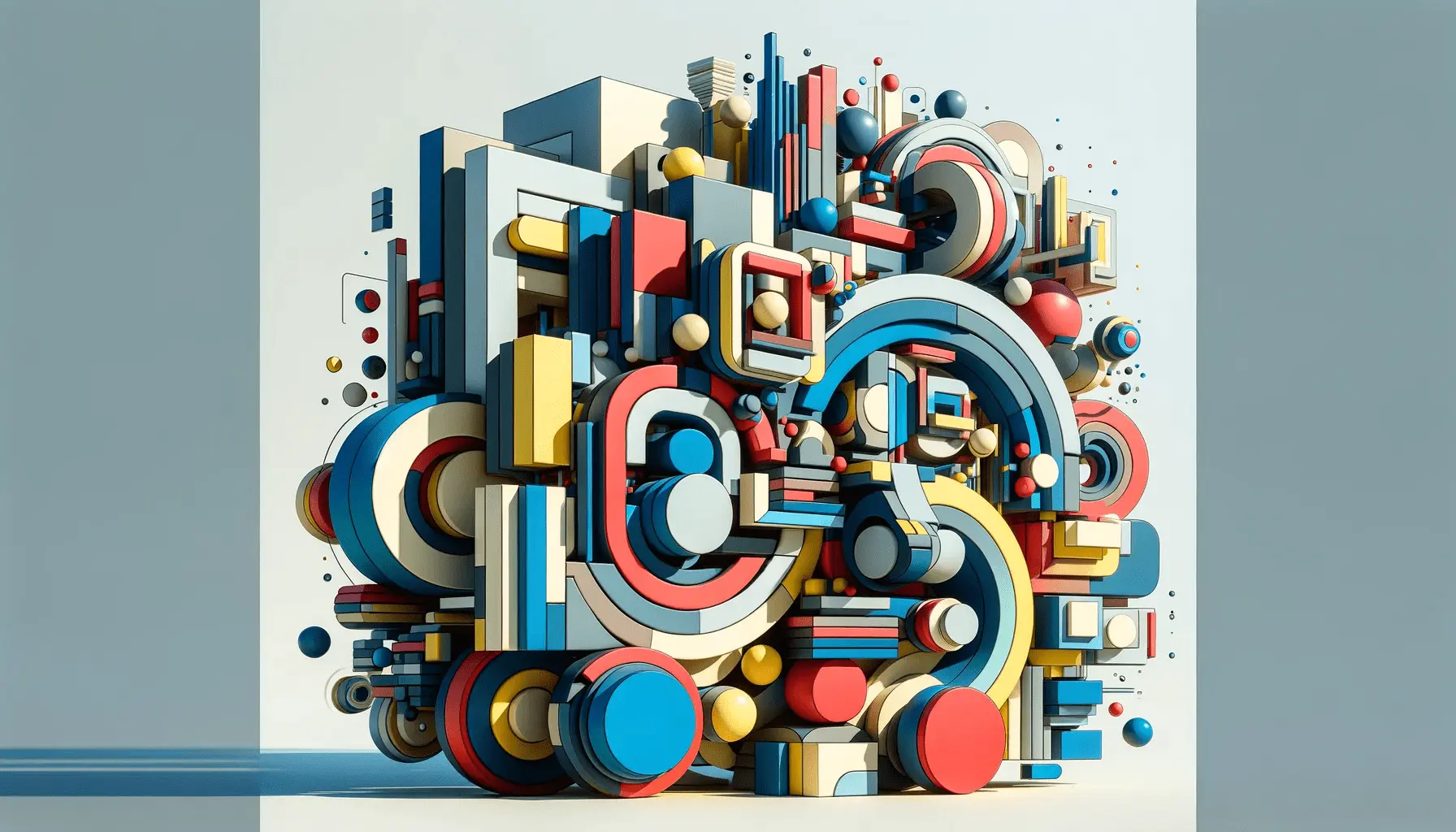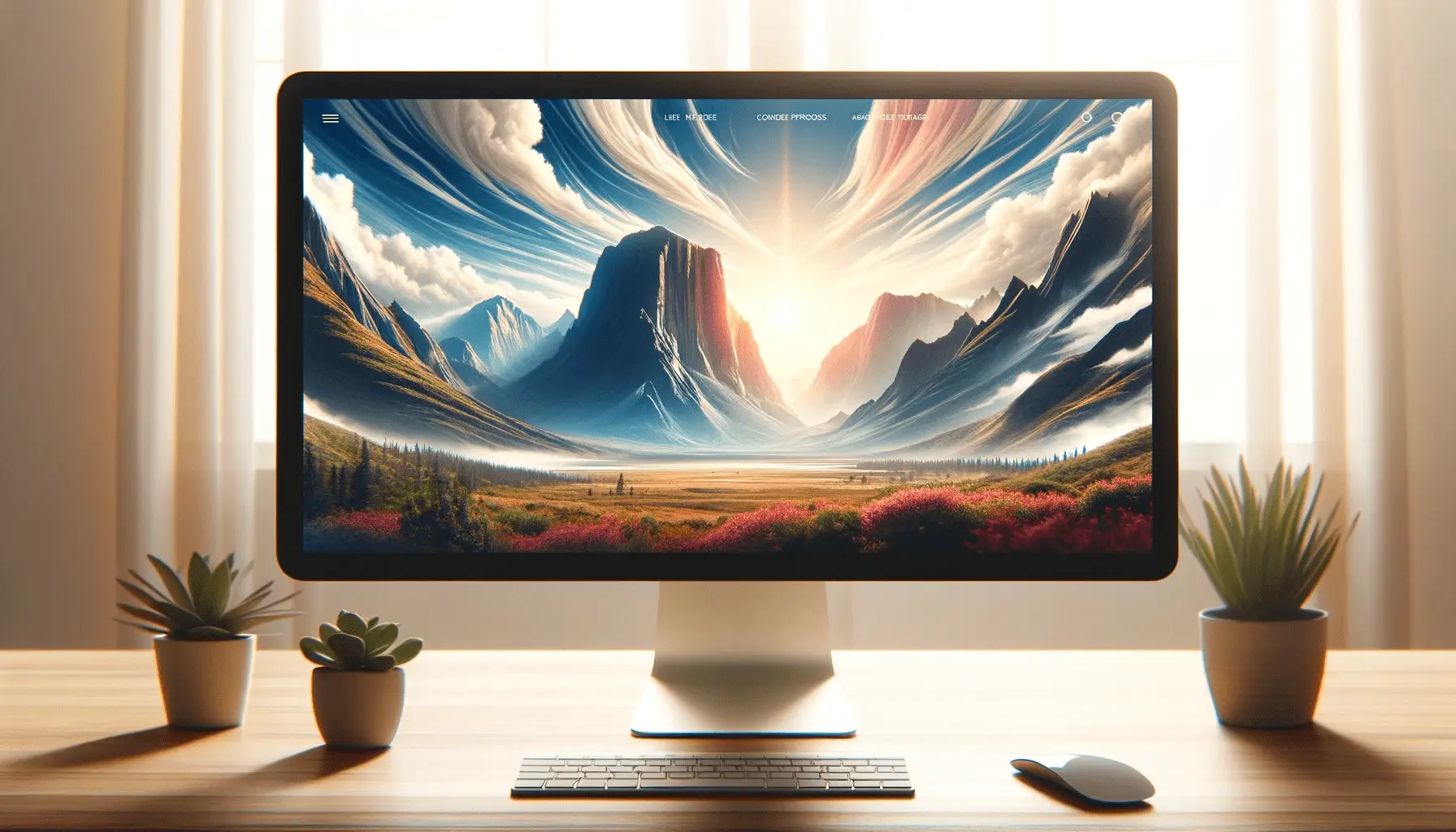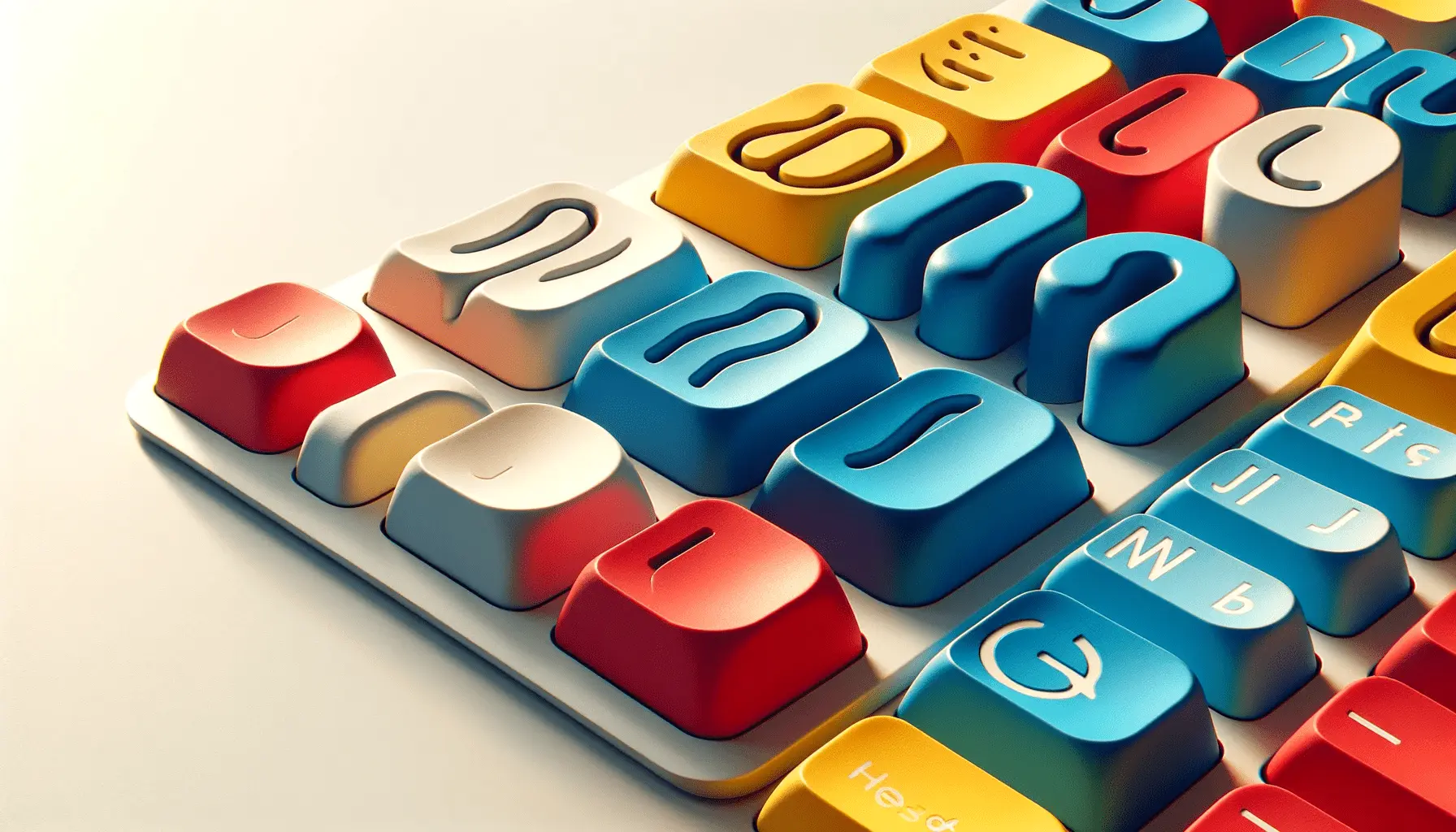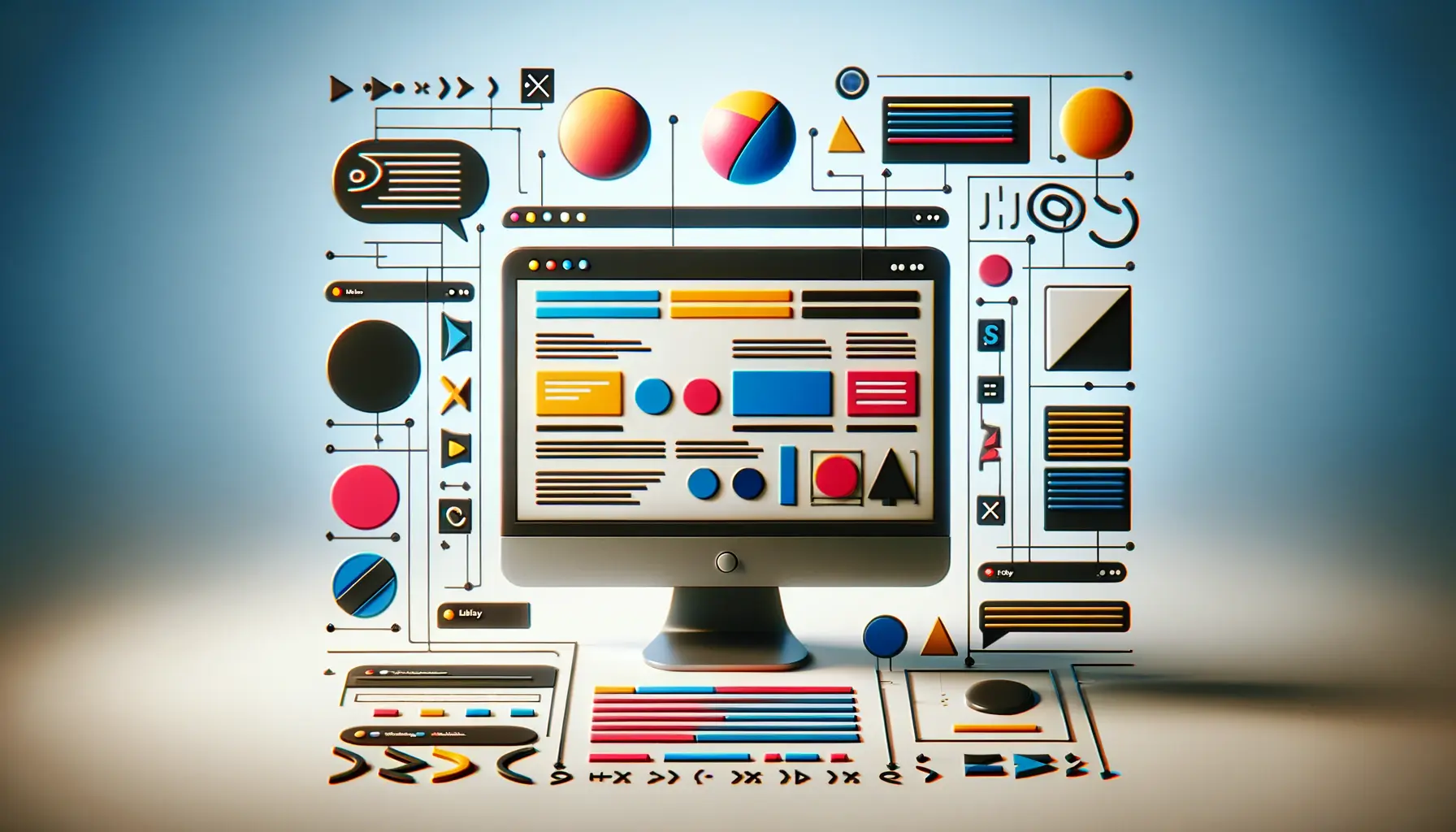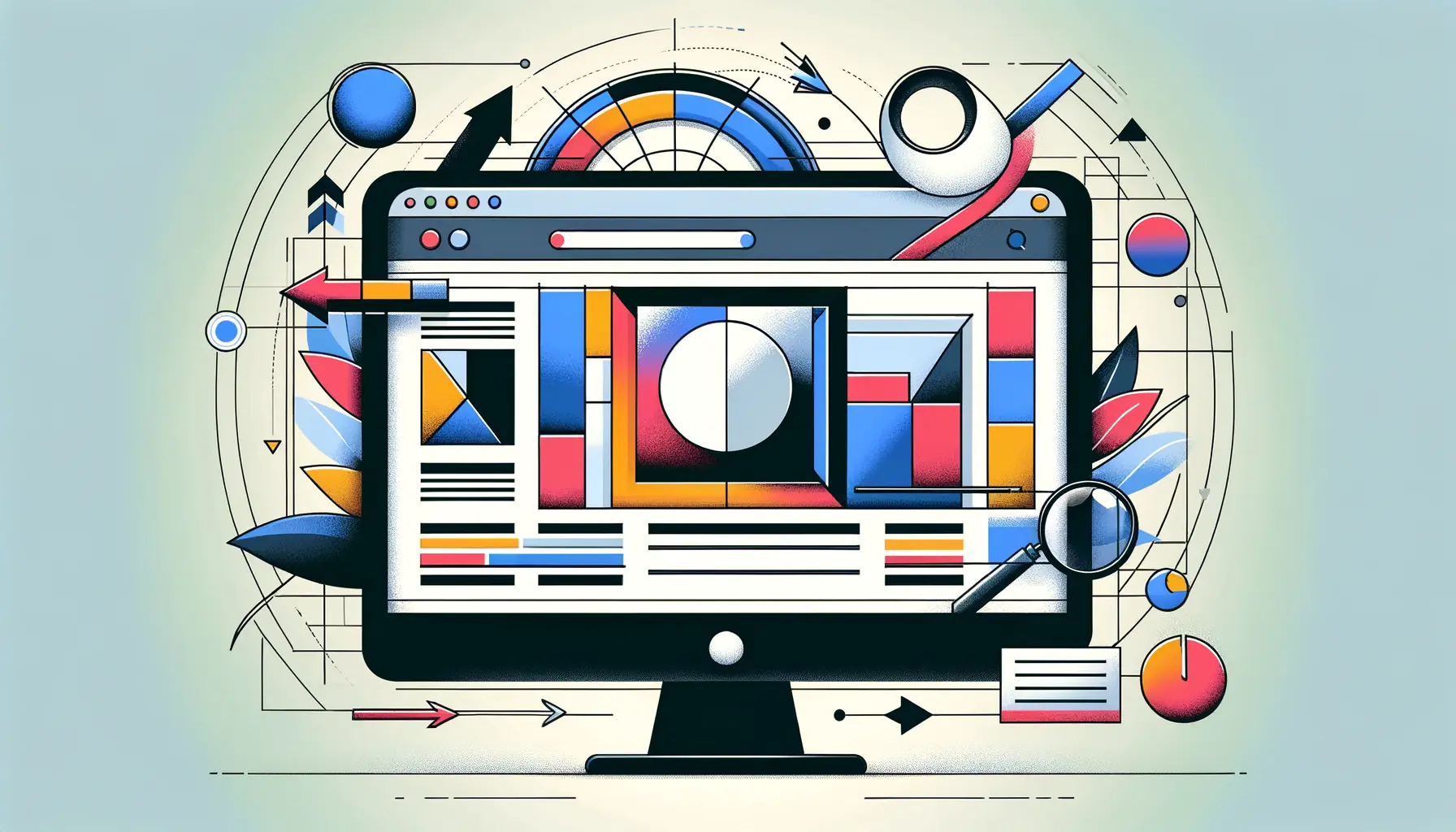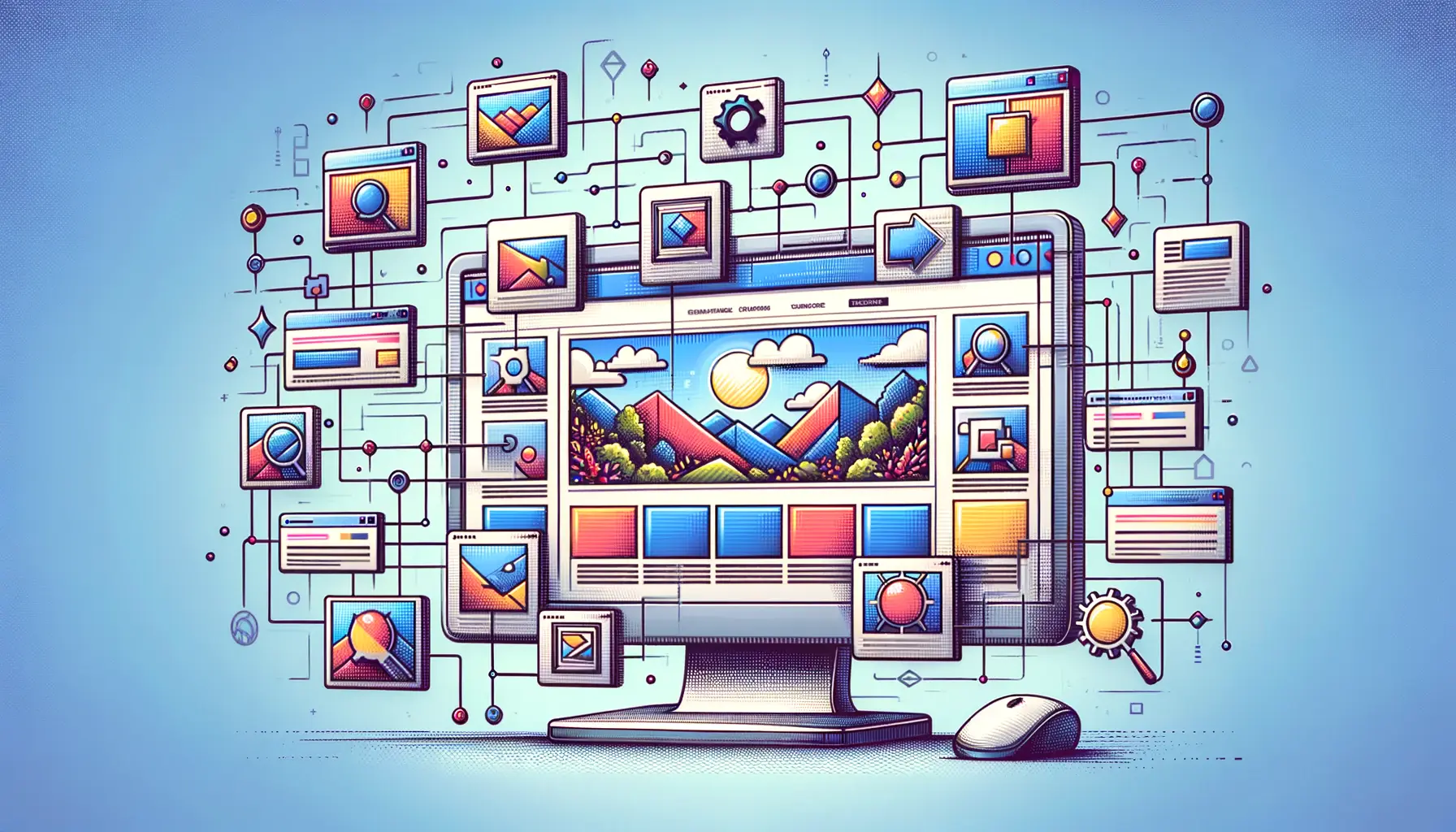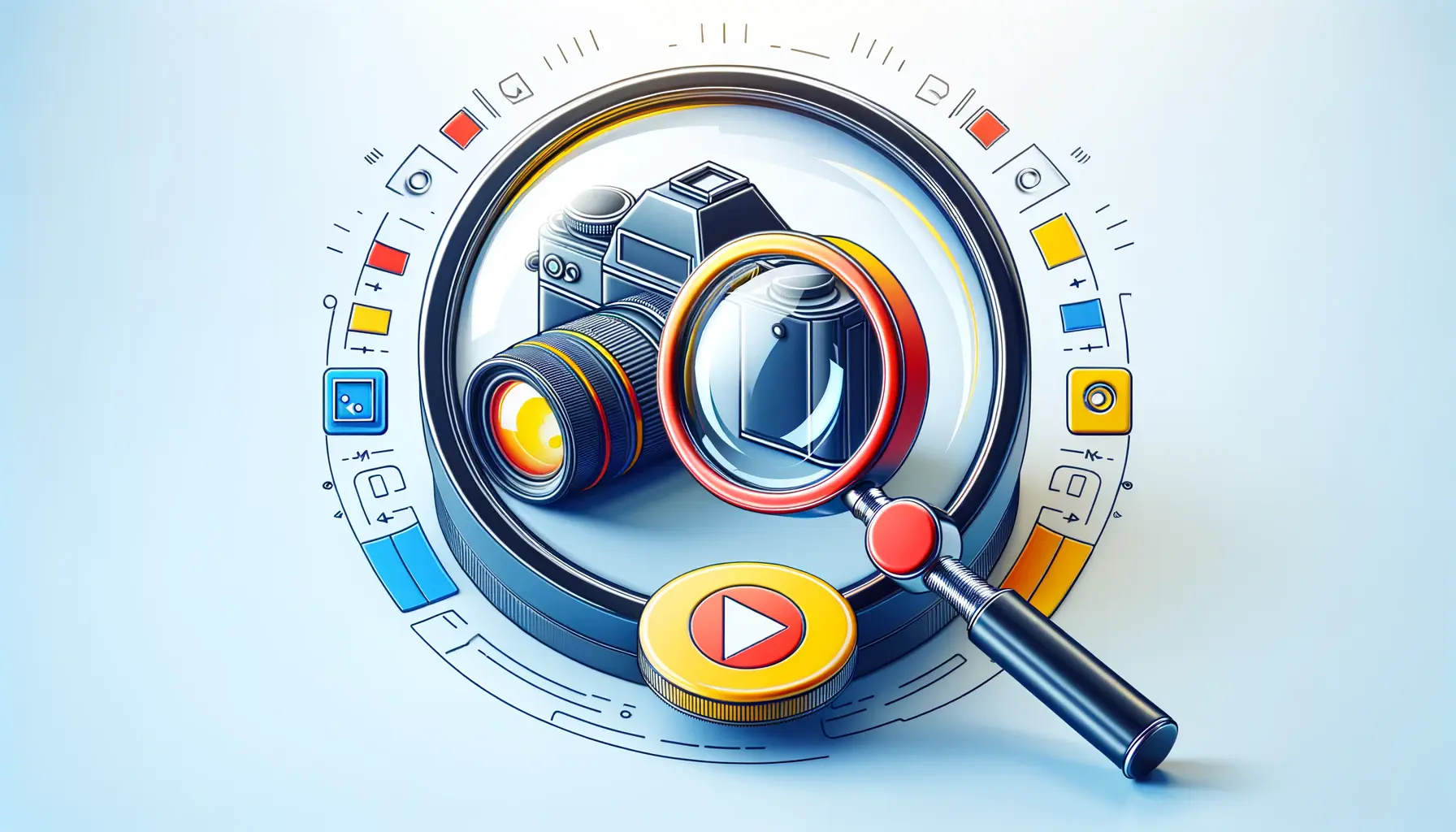In today’s high-speed web design world, first impressions are crucial.
When a user visits your site, the first things they encounter can make a huge difference in how they engage and interact with your content.
A great method for engaging users immediately is to use oversized typographicRelated to the style, arrangement, or appearance of printed letters or text. hero images.
Not only do these huge, in-your-face designs present your brand’s message in a brief, unmistakable way, but they establish the tone of the user experience as well.
But what in the world are oversized typographic hero images, anyway?
How have they evolved in web design, and why is size an issue of epic proportions in typography today?
Let’s dive deeper into the nuts and bolts of this trendy design trend.
- What Are Oversized Typographic Hero Images?
- Design Principles for Oversized Typographic Hero Images
- Benefits of Using Oversized Typography on Hero Pages
- Best Practices for Implementing Oversized Typographic Hero Images
- Prominent Examples of Oversized Typographic Hero Images in Web Design
- The Influence and Future of Oversized Typographic Hero Images
- Frequently Asked Questions Regarding Oversized Typographic Hero Images
What Are Oversized Typographic Hero Images?
Essentially, a hero imageA large banner image, often placed at the top of a webpage, used to capture attention and convey a message. is a large, prominent banner, typically at the top of a page, and the user’s first visual encounter with the site.
Traditionally, these hero spaces held high-quality photographs or illustrations.
But as design sensibilities changed and the trend toward minimalism increased, there has been a tendency to use large, bold typography in place of or in addition to images.
Defining Oversized Typographic Hero Images
An oversized typographic hero image makes use of large-scale text as the central visual element in the hero area.
This design strategy focuses on words and phrases, positioning them at center stage to directly convey the brand message or value propositionA statement that explains the unique benefits a product or service offers to customers..
The text’s enormity and prominence guarantee that visitors understand the central point without distraction.
The Evolution of Typography in Web Design
Typography has always been an integral part of web design, but its purpose has changed over time.
In the early days of the web, designers were limited to a handful of web-safe fontsA set of fonts that are widely supported across different web browsers and operating systems., leading to uninteresting and uninspired designs.
As technology improved, so did the tools and resources available.
The introduction of web fonts and services like Google Fonts expanded the typographic palette, allowing designers to be more creative and expressive.
This shift laid the groundwork for designers to experiment with type in novel ways.
The rise of minimalist design further established the importance of typography, leading to the widespread use of oversized typographic hero images as a bold visual statement in modern web design.
Why Size Matters in Typography
In web design, size is a powerful tool to establish hierarchy and draw attention.
The larger the text, the more attraction it commands, directing users to the most significant parts of a webpage.
By applying oversized typography in hero sections, designers can:
- Directly convey essential messages: Large letters make the main message clear and easy to read, reducing the chance of it being overlooked.
- Create visual impact: Oversized typography can be expressive and tone-setting, making the design more memorable.
- Enhance legibility: Larger text is easier to read, especially across various devices, improving the overall user experience.
Impact on User Experience and Branding
Purposeful use of oversized typographic hero images can significantly impact user experience and branding:
- Clarity and Focus: By removing unnecessary visuals and emphasizing powerful typography, users can immediately understand the site’s purpose or message.
- Brand Personality: Font size, style, and language can be used to express a brand’s personality—whether bold, sophisticated, playful, or serious.
- Memorability: Unique and distinctive typography is more likely to leave a lasting impact, making the brand more recognizable and memorable.
The use of oversized typographic hero images is more than just a stylistic choice; it’s a strategic approach to enhancing communication, reinforcing brand identity, and maximizing user engagement.
Oversized typographic hero images emphasize bold, large-scale text to instantly convey a brand’s message, setting the tone for user engagement.
Design Principles for Oversized Typographic Hero Images
Designing oversized typographic hero images requires careful consideration to ensure the typography is not only attention-grabbing but also enhances the overall user experience.
Now, let’s explore some of the most important principles to keep in mind:
Selecting the Proper Font Weight and Font Type
The choice of typeface plays a pivotal role in conveying your brand’s personality.
Opt for fonts that are visually interesting yet maintain readability.
A hand-drawn or unique font can add character, but it’s essential to ensure that it doesn’t compromise legibility.
When selecting a font weight, balance is key.
A weight that is too light may get lost in the design, while an overly bold weight can overpower other elements.
Strive for a weight that stands out without overwhelming the composition.
Balancing Readability and Visual Impact
While making a bold statement is the goal, readability must never be sacrificed.
Here are some key guidelines to achieve this balance:
- Contrast: Ensure that there is sufficient contrast between the background and text. This can be achieved by using contrasting colors or adding a semi-transparent overlay on the image.
- Whitespace: Provide ample whitespace around text to prevent overcrowding and allow typography space to breathe.
- Hierarchy: Use typographic hierarchy to guide the viewer’s eye, emphasizing the most important messages first.
Color, Contrast, and Background Considerations
Color choice significantly impacts the effectiveness of oversized typographic hero images:
- Brand Alignment: Choose colors that match your brand identity to create a uniform look.
- Contrast: High contrast between the background and text enhances readability. For instance, dark text over a light background or vice versa ensures the text stands out.
- Background Imagery: When placing text over an image, ensure the image is not too cluttered. Adding a light overlay will improve text legibility without detracting from the visual impact.
Responsive Design for Various Screen Sizes
With today’s multi-device world, ensuring your design resizes perfectly across different screen sizes is critical:
- Flexible Layouts: Employ responsive design techniques to adjust typography size and layout based on screen dimensions.
- Mobile Optimization: For mobile devices, use larger font sizes and simpler layouts to maintain readability. The ideal hero image size for mobile devices is 800 x 1,200 pixels.
- Testing: Regularly test your designs on different devices to ensure consistency and usability across platforms.
By carefully applying these design principles, you can create oversized typographic hero images that are both visually attractive and user-friendly, effectively conveying your brand’s message.
Effective use of oversized typography requires balance—choosing readable fonts, ensuring contrastThe difference in visual properties that makes an object distinguishable from its background., and optimizing layouts for different screen sizes.
Benefits of Using Oversized Typography on Hero Pages
Placing oversized typographic hero images in your web design has several advantages that can significantly increase user engagement and enhance brand visibility.
Let’s explore these benefits:
Creating Unquestionable Visual Hierarchy
The use of large-scale typography in hero sections establishes a clear visual hierarchy, directing users’ attention to the most crucial messages.
This approach ensures that visitors immediately understand the primary message or value proposition without distraction.
By using bold text, you can effectively guide the user’s eye and emphasize key points.
Strengthening Brand Identity and Recognition
Oversized typography allows brands to express their personality through font size, style, and type.
A distinctive typographic layout can make a brand more memorable and recognizable.
A unique or custom typeface prominently used in the hero section can become an iconic element of your brand, reinforcing brand identity and leaving a lasting impression on users.
Improving Accessibility and Legibility
Larger font sizes contribute to better readability, especially for users with visual impairments or those accessing your site on smaller screens.
By ensuring your key messages are presented in a clear and easy-to-read format, you improve the overall user experience and make your content more accessible to a wider audience.
This inclusivity can lead to higher user satisfaction and engagement.
Enhancing User Engagement and Retention
Engaging hero sections with bold typography can capture users’ attention, encouraging them to explore further.
A strong first impression increases the likelihood of visitors staying on your site longer, reducing bounce rates and improving retention.
An impactful oversized typographic hero image serves as an effective entry point, enticing users to delve deeper into your content or product offerings.
The strategic use of oversized typographic hero images can lead to a more visually compelling and effective website, ultimately supporting your business objectives and enhancing user satisfaction.
Using oversized typography enhances brand recognition, strengthens user engagement, and improves readability for a diverse audience.
Best Practices for Implementing Oversized Typographic Hero Images
Incorporating oversized typographic hero images into your web design can have a dramatic visual effect.
However, to achieve effectiveness, it is essential to follow best practices that harmonize functionality with aesthetics.
Below are key guidelines to follow:
1. Prioritize Your Headline
Begin with a compelling headline that encapsulates your main message.
The hero image must complement and enhance this headline so that the visual elements reinforce the textual content.
A well-crafted headline can significantly boost user engagement.
2. Make It Visually Relevant
Select typography and design elements that reinforce your brand identity and the message you want to convey.
Your oversized typographic hero image should tell your story at a glance, helping visitors quickly understand your offerings and brand personality.
3. Optimize for Performance
Large images can slow page loading times, negatively affecting user experience.
To ensure quick loading, compress your hero images without sacrificing quality.
Tools like TinyJPG or Adobe’s Photoshop Compressor can help with this optimization.
4. Keep It Clear and Simple
Avoid overcrowding the hero section with excessive text or multiple calls to action.
Focus on a single, distinct message to prevent overwhelming visitors.
A minimalistic approach ensures that users grasp your key message without distraction.
5. Use Clear Calls to Action (CTAs)
Include a prominent and effective CTA within the hero section to guide users toward desired actions, such as subscribing to a newsletter or browsing products.
Ensure the CTA stands out visually and remains easy to access.
6. Optimize for Multiple Devices
Ensure that your hero imagery and typography are responsive, providing a seamless viewing experience across different devices and screen sizes.
Responsive design enhances accessibility and improves the overall user experience.
By following these best practices, you can effectively use oversized typographic hero images to create an engaging and memorable user experience, strengthening your brand’s identity and connection with your audience.
- Choose fonts that reflect brand identity and ensure readability.
- Optimize images to prevent slow loading times.
- Maintain clear and concise messaging within the hero section.
Prominent Examples of Oversized Typographic Hero Images in Web Design
The implementation of oversized typographic hero images has become a key trend in modern web design, effectively capturing user attention and delivering powerful brand messages.
Here are some prominent examples that showcase this practice:
1. Bloomers
The Brazilian agency Bloomers utilizes a retro-inspired hero section with large, ’60s-style typography in bold purple, set against a black-and-white beach background.
This unique design approach aligns with their brand storytelling aesthetic.
2. Safari Riot
Safari Riot’s website features massive typography as the central visual element.
The bold and unconventional font choice makes a strong statement, perfectly complementing their forward-thinking brand identity.
3. Ekipa
Ekipa’s website embraces a clean and minimalist design, featuring a large, stylized logo composed of rectangular black shapes.
Their oversized typographic hero image underscores their focus on talent and artistic management.
4. Buck
Buck’s website opens with a vibrant hero section showcasing their logo in oversized, architecturally inspired typography.
Each letter represents a different design perspective, emphasizing the company’s diverse creative approach.
5. Savio Parsons
Savio Parsons’ website features a horizontally arranged, single-page layout that utilizes enormous typography to spell out the studio’s name.
The large letters, set in the Aeonik typeface, are seamlessly integrated with the content, reinforcing the studio’s architectural focus.
These examples highlight the versatility and impact of oversized typographic hero images in web design.
By using bold, attention-grabbing typography, brands can effectively communicate their identity and engage users with visually compelling experiences.
Leading brands effectively use oversized typography to create distinctive, memorable, and engaging web experiences.
The Influence and Future of Oversized Typographic Hero Images
The oversized typographic hero image has become a powerful design technique, shaping how brands communicate their identity and engage with audiences.
It is not just a visual trend but a strategic choice that enhances readability, user experience, and brand memorability.
As digital experiences continue to evolve, oversized typography remains a compelling way to make bold statements while maintaining accessibility and responsiveness.
Key Takeaways from Oversized Typography
- Better Visual Hierarchy: Large typography guides users’ attention to the most critical messages, ensuring seamless communication.
- Stronger Brand Identity: Unique and bold typography strengthens brand personality, making it more recognizable and memorable.
- Improved Readability and Accessibility: Large fonts enhance readability for all users, including those with visual impairments, ensuring a more inclusive experience.
- Increased Engagement and Retention: Eye-catching typography instantly captures attention, reducing bounce rates and encouraging deeper exploration.
- Optimized Performance Across Devices: Responsive typography delivers a consistent user experience across desktops, tablets, and smartphones.
The Future of Oversized Typographic Hero Images
As web design trends become more interactive and immersive, oversized typographic hero images will continue to be at the forefront of digital storytelling.
The future of this trend may include:
- Dynamic Typography: More websites will incorporate motion effects, such as text animations and interactive elements, to create visually engaging hero sections.
- AI-Based Personalization: Artificial intelligence will enable websites to adjust typography styles according to user preferences, providing a more personalized experience.
- Enhanced Accessibility Innovations: Designers will place greater emphasis on accessibility by ensuring oversized text remains easy to read and compliant with WCAG standards.
- Integration with Augmented Reality (AR): Future web interfaces may incorporate AR features, using oversized typography as an interactive gateway to immersive experiences.
Final Thoughts
Implementing oversized typographic hero images is not just a design choice—it is a strategic approach to modern digital branding.
When executed effectively, it captures attention, reinforces brand messaging, and enhances user experience.
Whether you’re designing for a corporate brand, creative agency, or e-commerce store, bold typography can set the stage for a lasting impression.
As technology evolves and user expectations shift, brands that leverage oversized typography with innovation and creativity will stay ahead of the curve.
Now is the time to experiment with typography, refine visual hierarchy, and create hero sections that leave a lasting impact—because in web design, the bolder, the better.
Future trends in oversized typography include AI-driven personalization, dynamic text animations, and greater accessibility considerations.
Quality web design is key for a great website! Check out our service page to partner with an expert web design agency.
Frequently Asked Questions Regarding Oversized Typographic Hero Images
An oversized typographic hero image is a large, impactful web banner that uses bold typography and visual elements to set the tone of a webpage.
They create a strong first impression, emphasize the brand message, and significantly boost user interaction while improving the visual appeal of a website.
Key considerations include text-image alignment, typography placement strategy, sizing, and maintaining consistency with the brand identity.
Yes, unless properly optimized, large typography can impact load times.
Using web-optimized images and following coding best practices helps maintain performance.
Design techniques such as layering, depth creation, interactive elements, and responsive design play a significant role in making hero images stand out.
Select fonts that reflect your brand personality without compromising readability.
Strong, unique typography is effective for capturing attention while ensuring legibility.
Yes, when designed responsively, oversized typographic hero images adjust to different screen sizes, providing a seamless user experience on all devices.
Avoid using fonts that are difficult to read, neglecting mobile responsiveness, and disrupting the balance between text and other design elements.
Perform A/B testingA method of comparing two versions of a webpage or element to determine which performs better. on different designs, collect user feedback, and analyze engagement metrics to assess the impact of your oversized typographic hero image.
